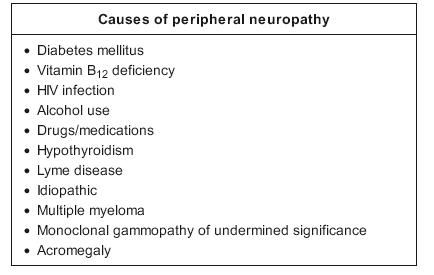multiple myleoma can cause peripheral neuropathy
- related: Neurology
- tags: #neurology

This patient's clinical features of bilaterally progressive distal sensory loss, ankle areflexia, and high-stepping ataxic gait with positive Romberg sign (reflecting loss of proprioceptive function) are consistent with peripheral neuropathy. Peripheral neuropathy can be caused by a variety of conditions, with diabetes mellitus and alcohol abuse being among the most common. Up to one-third of cases are idiopathic.
Diagnostic evaluation should be considered in patients when the etiology of neuropathy is unclear or in the setting of severe or rapidly developing symptoms. The initial workup may include laboratory studies such as blood glucose, vitamin B12, TSH, antinuclear antibody, rapid plasma reagin, hemoglobin A1c, erythrocyte sedimentation rate, complete blood count, and serum protein electrophoresis.
This patient's normocytic anemia and hypercalcemia raise suspicion for paraproteinemic neuropathy due to a plasma cell dyscrasia (eg, multiple myeloma).
The Romberg test (noting whether patients can maintain their balance with both feet together after closing their eyes) assesses proprioceptive ability, not cerebellar function (which is sometimes evaluated by pronator drift); a high-stepping gait and positive Romberg sign indicate likely neuropathic disease. Patients with cerebellar ataxia often cannot maintain balance regardless of visual cues.